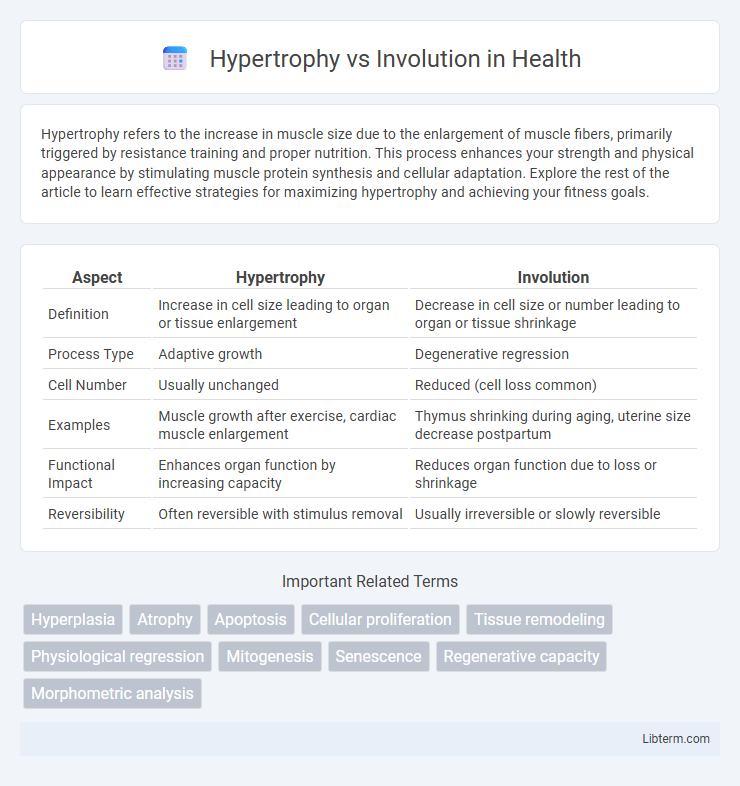Hypertrophy refers to the increase in muscle size due to the enlargement of muscle fibers, primarily triggered by resistance training and proper nutrition. This process enhances your strength and physical appearance by stimulating muscle protein synthesis and cellular adaptation. Explore the rest of the article to learn effective strategies for maximizing hypertrophy and achieving your fitness goals.
Table of Comparison
| Aspect | Hypertrophy | Involution |
|---|---|---|
| Definition | Increase in cell size leading to organ or tissue enlargement | Decrease in cell size or number leading to organ or tissue shrinkage |
| Process Type | Adaptive growth | Degenerative regression |
| Cell Number | Usually unchanged | Reduced (cell loss common) |
| Examples | Muscle growth after exercise, cardiac muscle enlargement | Thymus shrinking during aging, uterine size decrease postpartum |
| Functional Impact | Enhances organ function by increasing capacity | Reduces organ function due to loss or shrinkage |
| Reversibility | Often reversible with stimulus removal | Usually irreversible or slowly reversible |
Understanding Hypertrophy and Involution
Hypertrophy refers to the increase in cell size, resulting in the enlargement of a tissue or organ without an increase in cell number, commonly seen in muscle growth due to exercise. Involution involves the reduction in size or number of cells, leading to the shrinkage of an organ, often occurring naturally during aging or after the cessation of hormonal stimulation. Understanding hypertrophy and involution is crucial for comprehending physiological adaptations, tissue remodeling, and the body's response to external stimuli.
Defining Hypertrophy: Cellular Growth Explained
Hypertrophy refers to the increase in the size of individual cells, leading to organ or tissue enlargement without an increase in cell number. This cellular growth results from enhanced protein synthesis, increased organelle content, and greater cytoplasmic volume, often triggered by physiological stimuli such as resistance training or pathological conditions like cardiac hypertrophy. In contrast, involution involves the reduction or shrinkage of tissue or organ size due to cell loss or atrophy, highlighting the dynamic adaptability of cellular structures.
What is Involution? Mechanisms and Effects
Involution refers to the process of tissue shrinkage or reduction in size due to cell loss or atrophy, commonly observed in organs like the uterus after childbirth or the thymus with age. Mechanisms underlying involution include apoptosis, autophagy, and decreased cellular proliferation, leading to structural remodeling and functional decline. The effects of involution result in diminished organ mass and altered physiological capacity, crucial for normal development and aging processes.
Biological Significance of Hypertrophy
Hypertrophy refers to the increase in cell size, leading to the enlargement of a tissue or organ, which plays a crucial role in muscle growth and adaptation to increased workload. This biological process enhances the functional capacity of cells without increasing their number, supporting tissue resilience and repair. In contrast, involution involves the reduction in cell size or number, often associated with aging or the regression of tissues after functional decline.
Importance of Involution in Tissue Regulation
Involution plays a critical role in tissue regulation by enabling the systematic reduction of cell size and number, facilitating tissue remodeling and homeostasis after growth phases or injury repair. Unlike hypertrophy, which increases cell size and tissue mass, involution ensures the removal of excess or damaged cells, preventing abnormal tissue enlargement and maintaining functional balance. Proper involution is essential for processes such as mammary gland regression post-lactation and immune system adaptation, highlighting its importance in dynamic tissue regulation.
Key Differences Between Hypertrophy and Involution
Hypertrophy refers to the increase in cell size leading to organ enlargement without cell division, mainly seen in muscle growth due to exercise or hormonal stimulation. Involution involves the reduction in size and functional activity of an organ, often through cell shrinkage or apoptosis, commonly occurring in the thymus after puberty or the uterus postpartum. Key differences include hypertrophy's role in growth and increased capacity versus involution's function in regression and normalization of organ size.
Physiological Examples of Hypertrophy
Physiological hypertrophy occurs naturally in muscle cells during regular exercise, such as the increase in skeletal muscle size from resistance training or weightlifting. Cardiac hypertrophy can also be physiological, exemplified by the enlargement of the heart muscle in athletes, which improves cardiac output without pathological damage. In contrast, involution involves the reduction or shrinkage of an organ or tissue, like the thymus gland shrinking with age or mammary gland regression after lactation.
Clinical Scenarios Involving Involution
Involution refers to the process of organ shrinkage or tissue regression often seen in clinical scenarios such as post-lactational breast tissue reduction and thymic atrophy during aging or stress. Clinically, involution is significant in conditions like uterine involution following childbirth, where the uterus returns to its pre-pregnancy size, and in the regression of the mammary glands after cessation of breastfeeding. Understanding involution mechanisms aids in diagnosing and managing pathological states involving inadequate tissue regression or abnormal organ persistence.
Factors Influencing Hypertrophy and Involution
Hypertrophy is influenced primarily by mechanical stress, hormonal signals such as increased levels of growth hormone and insulin-like growth factor 1 (IGF-1), and nutrient availability, which stimulate cell enlargement and protein synthesis. Involution is driven by factors including reduced hormonal stimulation, activation of apoptotic pathways, and aging-related cellular signals leading to tissue shrinkage and cell loss. Both processes are regulated by complex molecular mechanisms that respond to physiological demands and environmental changes.
Implications for Health and Disease
Hypertrophy involves the enlargement of cells leading to increased organ size, often seen in muscle growth or cardiac adaptation, which can improve organ function but may also contribute to pathological conditions like hypertrophic cardiomyopathy. Involution refers to the reduction in size or functional capacity of organs due to cell shrinkage or apoptosis, commonly observed in aging tissues such as the thymus or mammary glands, potentially resulting in decreased immune response or hormonal changes. Understanding the balance between hypertrophy and involution is critical for developing targeted therapies in diseases such as cancer, heart failure, and age-related degenerative disorders.
Hypertrophy Infographic

 libterm.com
libterm.com